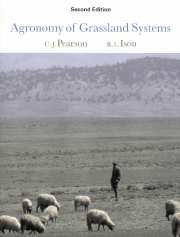Book contents
- Frontmatter
- Contents
- Preface
- 1 Overview: perspectives on grassland systems
- 2 The emergence of grassland systems
- 3 Generation
- 4 Vegetative growth
- 5 Flowering and seed production
- 6 Mineral nutrition
- 7 Herbage quality and animal intake
- 8 Grassland – animal interactions and management
- 9 Grassland systems design
- References
- Index
8 - Grassland – animal interactions and management
Published online by Cambridge University Press: 05 June 2012
- Frontmatter
- Contents
- Preface
- 1 Overview: perspectives on grassland systems
- 2 The emergence of grassland systems
- 3 Generation
- 4 Vegetative growth
- 5 Flowering and seed production
- 6 Mineral nutrition
- 7 Herbage quality and animal intake
- 8 Grassland – animal interactions and management
- 9 Grassland systems design
- References
- Index
Summary
In this chapter we are concerned with interactions between grassland and animals. Animals affect grassland productivity and botanical composition by selective grazing, pulling, treading, aiding seed dispersal (Chapter 3) and the return of nutrients to the ground (Chapter 6) and fouling. The importance of the effects of animals depends on the grazing management system. Grazing management systems can be defined as management systems designed to optimize the efficiency of production or total productivity of the livestock (in dollars, product or manager's satisfaction). Alternatively they may be seen as systems that have evolved through the interplay of human experience and the constraints and possibilities of the ‘natural’ environment. Thus, grazing management systems range from attempts to optimize the interaction between grassland and animals given an understanding of grass growth (Chapters 3–5), grass quality, animal intake and animal requirements (Chapter 7) to systems that attempt to sustain livelihoods in the long term (Chapter 9). These need not be mutually exclusive. Many systems involve conservation (Section 8.3), which may be an integral part of feed year planning (Section 8.4). The chapter concludes with an analysis of the efficiency of livestock production.
Animal effects on grassland
Selective grazing
Given the opportunity, all animals select some plant parts in preference to others and some species rather than others. The basis of this selection, and its consequences for intake, were discussed in Chapter 7. As availability decreases (or grazing pressure increases) selection is reduced (Section 7.4).
- Type
- Chapter
- Information
- Agronomy of Grassland Systems , pp. 140 - 160Publisher: Cambridge University PressPrint publication year: 1997



